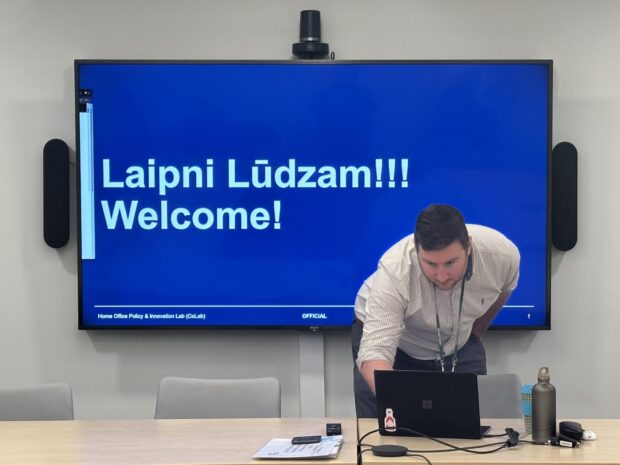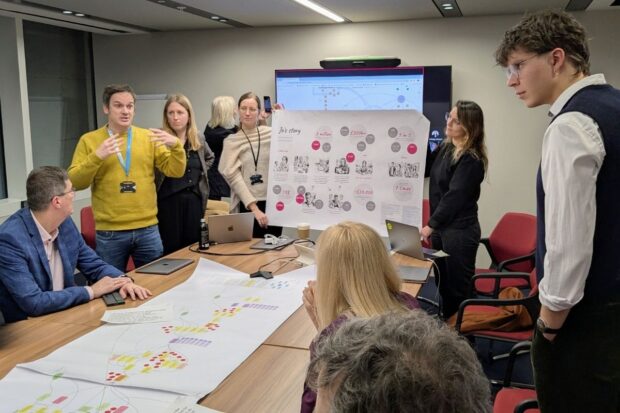
As political decisions grow more complex, and with ecological and social crises looming, it is clearer than ever that state administrations worldwide must be precise, efficient, and above all, relevant to their citizens. It was in this context that nearly five years ago, the Latvian State Chancellery launched the Innovation Laboratory initiative. In November 2024, continuing in that same vein, the Latvian Innovation Laboratory organized a visit by members of the Latvian state administration to design labs in the UK government.

As though to underscore the need for user-friendly public policy, this visit happened during public demonstrations against the introduction of a new inheritance tax on agricultural assets. Amid the “farmer protests,” sometimes even navigating through police-controlled crowds, 17 high-level civil servants from Latvia sought insights on how design is applied in government, meeting with design organisations across the UK’s public sector. The visit was hosted by the UK Civil Service’s Policy Design Community and we met policy design teams from Department for Business and Trade, Department for Education, Home Office, HM Revenue & Customs, and Ministry of Justice.
All the civil servants who participated seem to have gained valuable perspectives. Observing how interdisciplinary, upstream design work can help tackle contemporary challenges in state governance provided a new way of looking at their own roles. As often happens in the public sector, the real impact of this visit may take years to fully emerge. Yet the overarching themes from the trip could be of interest to many, offering both an alternative viewpoint on UK design work and a snapshot of how designers operate in the UK public sector as a whole.
Design hangover …the different views of design
As Malcolm Beattie (ex head of Northern Ireland’s Innovation Lab) once said, “the currency of public sector design is public value.” It is evident that incorporating design into government can generate unique insights, making services more cost-effective and better received by citizens. However, harnessing the full potential of government designers can be difficult because what design processes entail is often misunderstood. This can lead to friction between design labs and key stakeholders outside the “design bubble,” requiring extra effort to clarify design’s meaning and value—or, in the worst cases, threatening the very existence of these labs.
One lab lead described this challenge as working with a “design hangover” from the 20th century—a lingering assumption that design is purely industrial and only exists to produce tangible objects. In the public sector, there is sometimes an inertia favouring a linear approach to problem-solving, one that assumes a “product” is the only way to address an issue …a viewpoint fundamentally at odds with a designer’s mindset. Designers love the problem, not the solution. They operate at the intersection of why, where, and for whom. Reducing designers to merely creating new (and, of course, aesthetically pleasing) objects overlooks the deeper value they can provide.
Likewise, the role of testing is often misinterpreted. Prototyping and testing are core parts of the design process, allowing ideas to be validated quickly and inexpensively while gathering strong feedback. Yet testing is not always a concluding phase; it can take place at the beginning, middle, or end of building a solution. This sometimes clashes with a public sector culture that often emphasizes meetings and discussion before action, creating misalignment between policymakers and designers. One designer summed it up succinctly: if a picture is worth a thousand words, a prototype is worth a thousand meetings.
Conversations about a healthy design ecosystem also frequently involve how failure is perceived. A systematic fear of failure contradicts one of design’s central principles: if design is done well, every outcome—predicted or not—yields valuable lessons. Sometimes, the best “solution” is to create no product at all. In a worldview where design is only a product rather than a process, truly understanding the problem takes a back seat to delivering some form of “solution,” even though that understanding is a prerequisite for any good outcome.

Systematize, embed, communicate
Keeping these factors in mind, many discussions circled back to the million-dollar question: how do we convey the need for—and the value of—design methods to professionals unfamiliar with them? The challenge of systematizing design work, integrating it into existing practices, and presenting results in a universally understandable format is common to all design or innovation labs.
Nearly every lab we spoke with highlighted the importance of having a clear vision at the outset of a project, no matter its scale. A clear vision links the project to governmental priorities or to the host institution’s internal strategy, enabling labs to bring the right methods to the right problems rather than forcing a problem to fit a predefined methodology.
A clear vision should also translate into actionable goals. Goals serve not only as guides for achieving results but also as the basis for success metrics. These metrics, besides helping evaluate a lab’s internal work, can be communicated in ways that resonate with a broader audience. Many labs note that success often hinges on speaking “the language of Finance Ministries.” Every public service aims to make life better for citizens, but providing concrete data on exactly how this will happen leaves less room for doubt.
Moreover, outcomes rooted in theory and academic research—and demonstrated through metrics reflecting either success or failure—are potent communication tools for the public. Many labs operate in environments where political priorities shift frequently, and publicly accessible success stories can help safeguard their work when new political winds blow.
Understanding the user
Remaining in close contact with citizens is another reason design labs are unique and irreplaceable within government. One of the main advantages of applying design to problem-solving is that it takes users’ needs and experiences into account, providing solutions accordingly. In public services, these users are most often citizens themselves. As a result, many labs emphasize citizen engagement as a key strength. User research expertise and design skills that facilitate testing prototypes with citizens are often at the core of successful UK design lab projects.
The approaches for involving citizens in design work were as varied as the labs themselves. Sometimes it was as simple as inviting a group of citizens to share their views over pizza. Other times, labs studied people in their own environments to better understand and empathise with their routines. Others used “low-resolution” environments—digital, virtual, or physical—to see first hand how people interact with a potential solution. Certain labs also pointed out that user research need not be uni-directional: by teaching design skills to the community, labs can uncover insights while also empowering citizens. We came away inspired to incorporate that approach into some of the Latvian Innovation Laboratory’s own projects.

Collaboration, interdisciplinarity, and close connections
Finally, every design lab we visited operated on the principle that the collective capability of a diverse group of professionals outweighs the sum of their individual skills. Each lab took measures to reduce silos, bringing together user researchers, designers, developers, and stakeholders around one table. This arrangement offers numerous benefits.
For instance, everyone can bring their expertise to bear early in the process. Design skills are as relevant in conceptual stages as they are in prototyping. User researchers and developers may have insights that, if recognized in the beginning, could save time and resources down the line. Similarly, involving stakeholders at the developmental stage keeps them anchored to the initial problem and clarifies where ownership lies.
Moreover, broad participation ensures that each role shares a common vision. In addition to fostering a closer working relationship, it also allows for more efficient hand-offs—for example, from user researchers to designers. Interdisciplinary teamwork can further optimize each contributor’s professional capabilities, particularly for designers. Their essential role in the public sector is bridging the gap between policy and the public. Including designers early in a project lets them perform that role far more effectively. Many design labs are structured to encourage this widespread interaction with policymakers.
In short, the Latvian state administration’s visit to these UK design labs provided an eye-opening look at how design methods can support better governance. While the lasting impact of the visit may unfold gradually, the lessons learned—from challenging the “design hangover” to adopting prototypes as communication tools, and from fostering interdisciplinary collaboration to keeping citizens at the heart of design—are relevant to anyone interested in how public services can become more effective and meaningful.
Join our community
We use this blog to talk about the work of the multidisciplinary policy design community. We share stories about our work, the thinking behind it and what policymaking might look like in the future. If you would like to read more, then please subscribe to this blog. If you work for the UK's government, then you can you join the policy design community. If you don't work for the UK government, then connect with us on social media at Design and Policy Network and subscribe here to be notified about our monthly speaker events to hear from influential design thought leaders and practitioners.